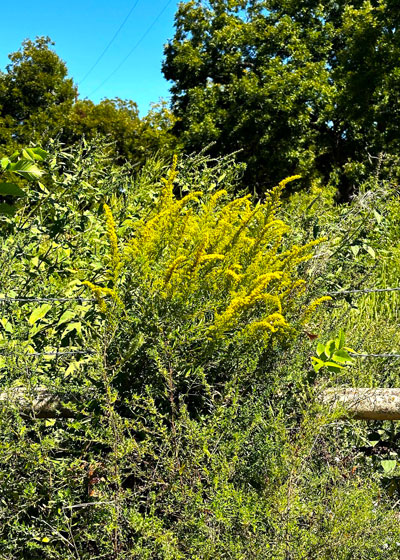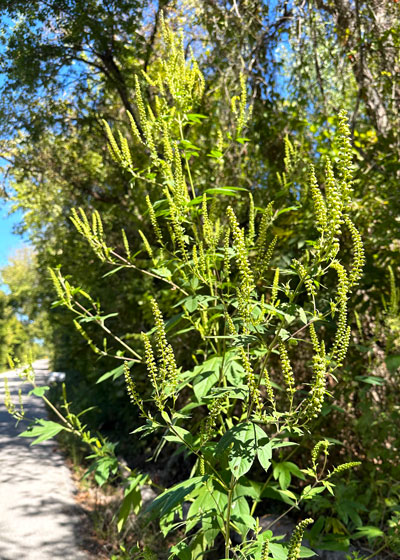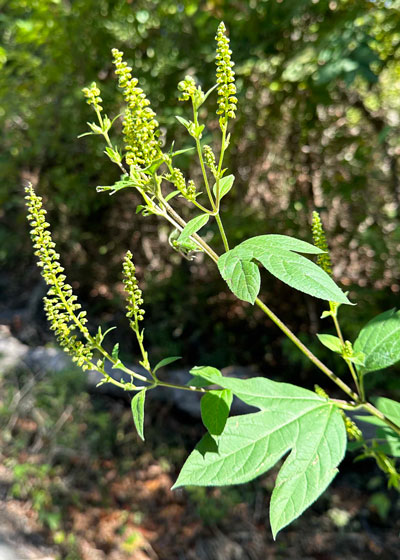On the “Most Wanted List” for fall
I can do this in 5 little paragraphs. (Not counting this one.)

1. To cause allergic reactions, pollen must blow through the wind to your nostrils. That’s why you’ll see allergy reports on TV listing oaks, pecans, cedars, grasses … and ragweed, among many others, depending on the season. All of these have dust-like pollen that glides on the breeze.
2. Plants that are pollinated by bees, butterflies, moths, and hummingbirds have sticky pollen that is carried on the bees’, butterflies’, moths’, and hummingbirds’ mouthparts from the female flowers to the male flowers. That pollen is too heavy, too gooey, to be carried by the wind.
3. In my time watching and photographing Texas flowers and wildflowers, I believe the single largest number of bees and butterflies I’ve ever seen were around a roadside clump of goldenrod plants in full bloom in October. There were literally hundreds of pollinators.
4. Those ragweed plants you hardly notice in the background of my photo here are absolutely loaded with flowers. Inconspicuous flowers that are, in turn, loaded with pollen. Enough to choke up Houston, Dallas, Fort Worth, Austin, San Antonio, and Dogtown (where I took this photo) for weeks.
5. Just because goldenrod blooms at the same time and in the same places as ragweed, don’t throw it under the mulching mower. Goldenrod is one of our most beautiful (and harmless) fall-flowering perennials. It’s widely available from the best garden centers around, and if any of your over-the-fence critics complains that you’re growing it, just suggest they go talk to the (humming)birds and the bees. They have the straight scoop on what plants are good and what plants are bad.
Need a learned second opinion? Would you settle for something from North Carolina State University? Here’s a great (short) video.
Or the Missouri Botanical Gardens?
Or the University of Wisconsin?
Or Louisiana State University?
The Royal Horticulture Society? (The Brits like it! Look at the photo they have.)
And… as one of many possible sources, Plant Delights in North Carolina (hope they’re OK after Helene) lists 6 exotic-sounding cultivars. Names like ‘Fireworks’ and ‘Yellow Rockets’ along with ‘Golden Fleece’ (really pretty) and ‘Montana Minnie.’
Now, as for the blasted ragweed…
This nasty annual weed grows pretty much everywhere there are roadsides and moisture clear across Texas.

In my own county (Collin County, just northeast of Dallas), I can show you ragweed plants that have struggled to grow to 3 ft. tall because of shallow, rocky soils. I can also show you ragweed plants that are 10 or 12 ft. tall because they are growing in ditches and stream beds where the soil is rich and uniformly moist.
Ragweed in an annual plant that germinates in spring with inconspicuous seedlings with deeply lobed leaves. It branches freely from the beginning.

Ragweed plants are in full bloom now with their spikes of green flowers filled with dry pollen. Look closely at its leaves so you will recognize them next spring and summer when the plants are young and growing actively. That’s the time you can control them most easily with a broadleafed weedkiller spray containing 2,4-D or with a vegetation killer such as a glyphosate-only herbicide. Mowing and cutting them down will also prevent development of pollen.
Your take-away from it all…
Help spread the word: Goldenrod is beautiful. Goldenrod is Good!
